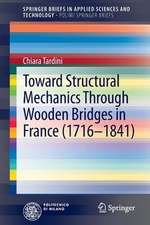The Paramount Role of Joints into the Reliable Response of Structures: From the Classic Pinned and Rigid Joints to the Notion of Semi-rigidity: NATO Science Series II: Mathematics, Physics and Chemistry, cartea 4
Editat de C.C. Baniotopoulos, F. Walden Limba Engleză Paperback – 31 dec 2000
Readership: An incomparable resource for engineers who analyze and design steel, composite and timber structures; researchers and graduate students in the same areas.
Din seria NATO Science Series II: Mathematics, Physics and Chemistry
- 18%
 Preț: 1272.32 lei
Preț: 1272.32 lei - 15%
 Preț: 644.30 lei
Preț: 644.30 lei - 18%
 Preț: 1848.33 lei
Preț: 1848.33 lei - 18%
 Preț: 1235.76 lei
Preț: 1235.76 lei - 15%
 Preț: 649.87 lei
Preț: 649.87 lei - 18%
 Preț: 957.75 lei
Preț: 957.75 lei - 15%
 Preț: 656.58 lei
Preț: 656.58 lei - 18%
 Preț: 1235.43 lei
Preț: 1235.43 lei - 18%
 Preț: 960.13 lei
Preț: 960.13 lei - 18%
 Preț: 1225.79 lei
Preț: 1225.79 lei - 15%
 Preț: 666.41 lei
Preț: 666.41 lei - 18%
 Preț: 1835.07 lei
Preț: 1835.07 lei - 15%
 Preț: 640.71 lei
Preț: 640.71 lei - 18%
 Preț: 954.45 lei
Preț: 954.45 lei - 18%
 Preț: 1227.36 lei
Preț: 1227.36 lei - 15%
 Preț: 646.11 lei
Preț: 646.11 lei - 18%
 Preț: 948.61 lei
Preț: 948.61 lei -
 Preț: 400.10 lei
Preț: 400.10 lei - 18%
 Preț: 959.82 lei
Preț: 959.82 lei - 18%
 Preț: 944.19 lei
Preț: 944.19 lei - 18%
 Preț: 1838.38 lei
Preț: 1838.38 lei - 18%
 Preț: 1222.49 lei
Preț: 1222.49 lei - 18%
 Preț: 939.94 lei
Preț: 939.94 lei - 18%
 Preț: 950.66 lei
Preț: 950.66 lei - 18%
 Preț: 957.44 lei
Preț: 957.44 lei - 15%
 Preț: 656.74 lei
Preț: 656.74 lei
Preț: 398.15 lei
Nou
Puncte Express: 597
Preț estimativ în valută:
76.19€ • 81.47$ • 63.52£
76.19€ • 81.47$ • 63.52£
Carte tipărită la comandă
Livrare economică 18 aprilie-02 mai
Preluare comenzi: 021 569.72.76
Specificații
ISBN-13: 9780792367017
ISBN-10: 0792367014
Pagini: 451
Ilustrații: XI, 451 p.
Dimensiuni: 160 x 240 x 24 mm
Greutate: 0.65 kg
Ediția:2000
Editura: SPRINGER NETHERLANDS
Colecția Springer
Seria NATO Science Series II: Mathematics, Physics and Chemistry
Locul publicării:Dordrecht, Netherlands
ISBN-10: 0792367014
Pagini: 451
Ilustrații: XI, 451 p.
Dimensiuni: 160 x 240 x 24 mm
Greutate: 0.65 kg
Ediția:2000
Editura: SPRINGER NETHERLANDS
Colecția Springer
Seria NATO Science Series II: Mathematics, Physics and Chemistry
Locul publicării:Dordrecht, Netherlands
Public țintă
ResearchCuprins
List of Contents.- 1.1 Effects of the Actual Joint Behaviour on the Design of Steel Frames.- 1.2 Behavior and Design of Partially-Restrained Composite Framing Systems.- 1.3 Prediction of Ultimate Load of Steel Frames with Semi-rigid Connections.- 1.4 Effective Length Factor Considering Semi-rigid Connections.- 1.5 Practical Demonstration of the Use of Joint Flexibility in Steel Frame Design.- 1.6 Development, Design and Testing of Joints in Composite Structures.- 1.7 Application of the Theory of Semi-rigid Joints into Steel and Composite Structures.- 1.8 Wind Effects on Large Antennas and Telecommunication Towers: Analysis and Design of Main Components and Joints.- 2.1 Application of Deformation Criteria in Bolted Connection Strength Design.- 2.2 Large-scale Experimental Tests on Steel and Composite Frames.- 2.3 Cyclic Tests on Bolted Steel Double-Sided Beam-to -Column Joints.- 2.4 Experimental Investigation of Load Carrying Capacity of the Joints into an Aluminium Dome.- 2.5 Experimental and Analytical Studies on the Cyclic Behaviour of Column-Base Joints.- 2.6 Bolted Joints in Thin Walled Cross-sections of Type Z Made from Cold Formed Steei.- 2.7 Review and Classification of Semi-rigid Connections.- 3.1 Behaviour of Connections of Seismic Resistant Steel Frames.- 3.2 Observed Beam Column Joint Failures During the 17 August 1999-Kocaeli and 12 November 1999-Duzce, Turkey Earthquakes.- 3.3 Influence of Semi-rigid and/or Partial-strength Joints on the Seismic Performances of Steel MRF.- 3.4 Cyclic Behaviour of End-Plate Beam-to-Column Composite Joints.- 3.5 A Nonconvex Optimization Approach for the Determination of the Capacity Curve and the Performance Point of MR Steel Frames Exhibiting Softening under Seismic Loading.- 3.6 Bi-directional Pseudodynamic Test of a Full-size Three Storey Steel Concrete Building with Rigid and Semi-rigid Joints.- 3.7 Influence of Joint Flexibility in the Seismic Performance of Moment Resisting Steel Frames.- 3.8 Dynamic Analysis of Stiffened Coupled Shear Walls with Flexible Connections under Earthquake Effects.- 4.1 Numerical Modelling of the Structural Behaviour of Joints.- 4.2 Cyclic Analysis of Structural Joints by Computational Models.- 4.3 A Contribution to the Finite Element Study of Pin Connections in Steel Structures.- 4.4 Recent Advances in the Numerical Modelling of the Response of Structural Steelwork Taking into Account Softening in Connection Behaviour.- 4.5 Finite Element Analyses of Steel-Concrete Subassemblage with Partial Shear Connection.- 4.6 Butt-Welded Aluminium Joints: a Numerical Study of the HAZ Effect on the Ultimate Tension Strength.- 5.1 Designing Structural Joints according to Eurocodes.- 5.2 Rotation Capacity of Steel Joints: Verification Procedure and Component Tests.- 5.3 Review of Deformation Capacity of Joints Related to Structural Reliability.- 5.4 Modelling of Joints of Sandwiches Panels.- 5.5 New Design Concepts for Structural Timber Connections.- 5.6 Timber Joints Loaded Perpendicular to the Grain: Long-term Strength, Theory and Experiments.- 5.7 Component Method for Historical Timber Joints.- 5.8 Application of the Component Method to Steel Joints under Fire Loading.- 5.9 Stiffness of Lap Joints with Preloaded Bolts.- Authors Index.

















